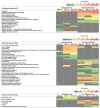Transcriptome Analysis Unveils Molecular Mechanisms of Acaricide Resistance in Two-Spotted Spider Mite Populations on Hops
- PMID: 39769060
- PMCID: PMC11678639
- DOI: 10.3390/ijms252413298
Transcriptome Analysis Unveils Molecular Mechanisms of Acaricide Resistance in Two-Spotted Spider Mite Populations on Hops
Abstract
Broad-spectrum crop protection technologies, such as abamectin and bifenthrin, are globally relied upon to curb the existential threats from economic crop pests such as the generalist herbivore Tetranychus urticae Koch (TSSM). However, the rising cost of discovering and registering new acaricides, particularly for specialty crops, along with the increasing risk of pesticide resistance development, underscores the urgent need to preserve the efficacy of currently registered acaricides. This study examined the overall genetic mechanism underlying adaptation to abamectin and bifenthrin in T. urticae populations from commercial hop fields in the Pacific Northwestern region of the USA. A transcriptomic study was conducted using four populations (susceptible, abamectin-resistant, and two bifenthrin-resistant populations). Differential gene expression analysis revealed a notable disparity, with significantly more downregulated genes than upregulated genes in both resistant populations. Gene ontology enrichment analysis revealed a striking consistency among all three resistant populations, with downregulated genes predominately associated with chitin metabolism. In contrast, upregulated genes in the resistant populations were linked to biological processes, such as peptidase activity and oxidoreductase activity. Proteolytic activity by peptidase enzymes in abamectin- and bifenthrin-resistant TSSM populations may suggest their involvement in acaricide metabolism. These findings provide valuable insights into the molecular mechanisms underlying acaricide resistance in the TSSM. This knowledge can be utilized to develop innovative pesticides and molecular diagnostic tools for effectively monitoring and managing resistant TSSM populations.
Keywords: RNA sequencing; acaricide resistance; metabolic detoxification; two-spotted spider mite.
Conflict of interest statement
The authors declare no conflicts of interest.
Figures






Similar articles
-
Resistance to pyridaben in Canadian greenhouse populations of two-spotted spider mites, Tetranychus urticae (Koch).Pestic Biochem Physiol. 2020 Nov;170:104677. doi: 10.1016/j.pestbp.2020.104677. Epub 2020 Aug 12. Pestic Biochem Physiol. 2020. PMID: 32980052
-
P8 nuclear receptor responds to acaricides exposure and regulates transcription of P450 enzyme in the two-spotted spider mite, Tetranychus urticae.Comp Biochem Physiol C Toxicol Pharmacol. 2019 Oct;224:108561. doi: 10.1016/j.cbpc.2019.108561. Epub 2019 Jun 26. Comp Biochem Physiol C Toxicol Pharmacol. 2019. PMID: 31254664
-
Abamectin is metabolized by CYP392A16, a cytochrome P450 associated with high levels of acaricide resistance in Tetranychus urticae.Insect Biochem Mol Biol. 2014 Mar;46:43-53. doi: 10.1016/j.ibmb.2014.01.006. Epub 2014 Jan 23. Insect Biochem Mol Biol. 2014. PMID: 24463358
-
Acaricide resistance mechanisms in the two-spotted spider mite Tetranychus urticae and other important Acari: a review.Insect Biochem Mol Biol. 2010 Aug;40(8):563-72. doi: 10.1016/j.ibmb.2010.05.008. Epub 2010 Jun 8. Insect Biochem Mol Biol. 2010. PMID: 20685616 Review.
-
Toxicodynamic mechanisms and monitoring of acaricide resistance in the two-spotted spider mite.Pestic Biochem Physiol. 2015 Jun;121:97-101. doi: 10.1016/j.pestbp.2014.12.011. Epub 2014 Dec 15. Pestic Biochem Physiol. 2015. PMID: 26047116 Review.
Cited by
-
Acaricide Resistance Monitoring and Structural Insights for Precision Tetranychus urticae Management.Insects. 2025 Apr 23;16(5):440. doi: 10.3390/insects16050440. Insects. 2025. PMID: 40429153 Free PMC article.
References
-
- NASS-USDA . National Hop Report. NASS-USDA; Washington, DC, USA: 2023.
-
- Gent D.H., Barbour J.D., Dreves A.J., James D.G., Parker R., Walsh D.B., O’Neal S. Field Guide for Integrated Pest Management in Hops. Oregon State University; Corvallis, OR, USA: University of Idaho; Moscow, IA, USA: USDA Agricultural Research Service; Washington, DC, USA: Washington State University; Washington, DC, USA: 2009.
MeSH terms
Substances
Grants and funding
LinkOut - more resources
Full Text Sources

